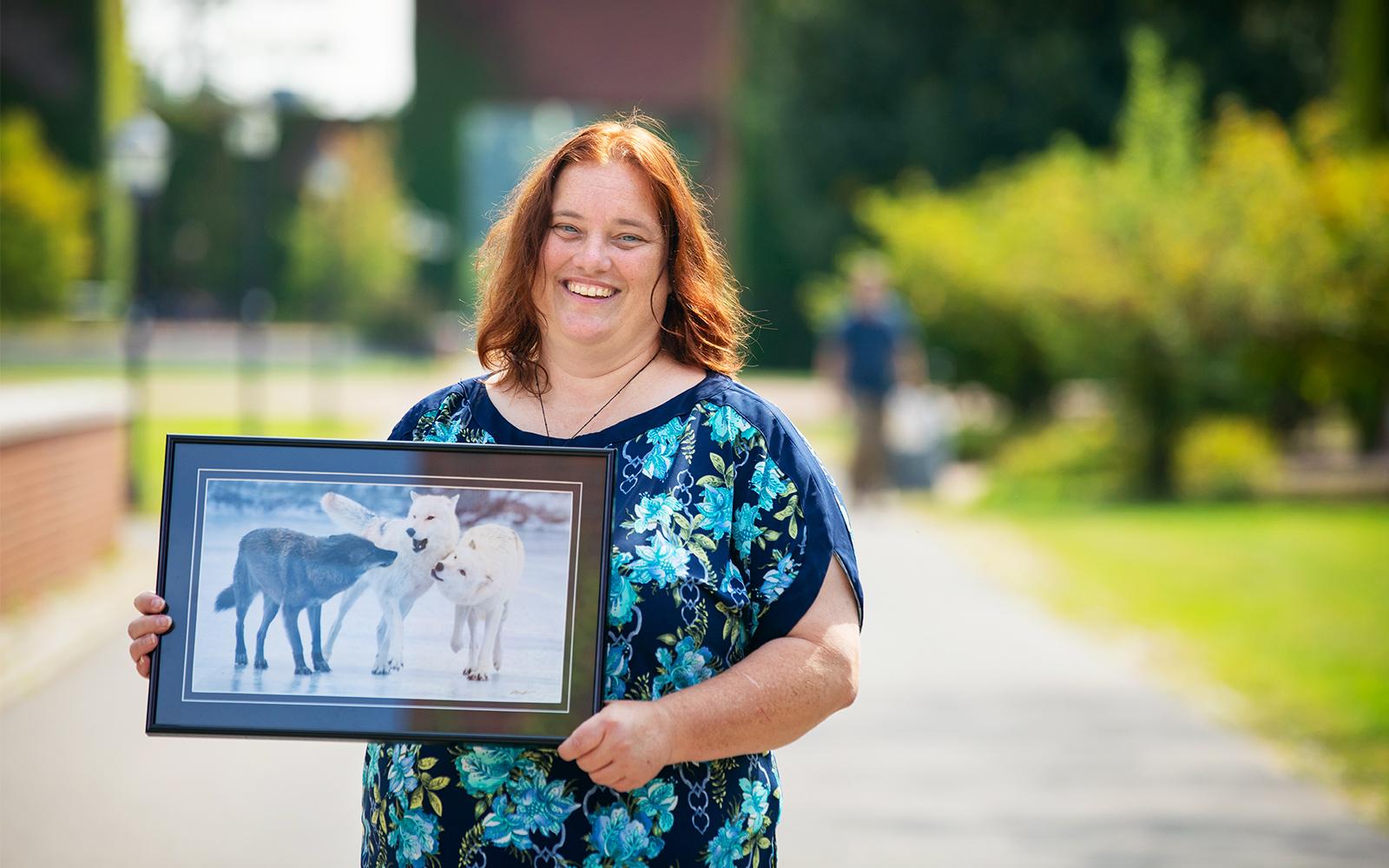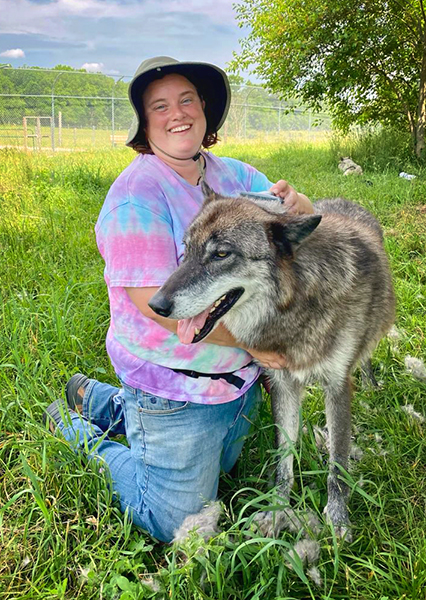As lightning and thunder streak and rattle through the night sky, Dr. Karen Davis enters a small wooden hut to comfort a pack of wolves. A scary proposition for many, but Davis is unfazed as she hunkers down in the rain-drenched enclosure.
“When you work with wolves for many years as I have, and raise them, it’s normal for me. I’ve slept in the same room with wolves recovering from surgery, I’ve spent 24 hours with adult wolves, and I’ve done a lot of vet tech work like giving shots. I’ve been covered in mud working with wolves, pulling an angry wolf off somebody. That is not something most people can do. It’s relationship-building and it’s also a skill,” Davis said.

Now a psychology professor at SUNY Potsdam, Davis brings years of experience from the field, back into the classroom. As she stands at the front of the room discussing her numerous research projects and hands-on work with wolves and other wild animals over the years, her anecdotes connect to the theoretical discussions with her students. From Introduction to Psychology and Biopsychology to Animal Behavior and Elements of Behavior Modification—and even a Dogs and Wolves class in the fall of 2023—Davis’s real-world experiences strengthen the unique interdisciplinary courses.
“I’ve spent years working with socialized wolves, teaching the public, and teaching in an academic setting. My background is varied, and that’s what many students like is that I can talk about anything, and I can usually give them a real-life example."

Her dedication to the field of psychology, through the lens of animal behavior, began as an undergraduate student at Purdue University. As she worked on her degree in biology, one of her professors was studying the breeding behavior of wolves at Wolf Park, a nearby educational and research facility for the endangered species. “I spent many hours working with wolves and raising them. I was observing and collecting all the data. It was just an undergraduate project, but it got me interested in research and animal behavior,” Davis said.
When she graduated, she accepted her first full-time job as a zookeeper, where she trained sea lions, worked with bears and tigers, and raised a Siberian Lynx at the Utica Zoo. She also started working as a consultant for Wolf Timbers, another organization where she raised wolf puppies. After a couple of years at the zoo, she was ready to jump back into research once again, and she enrolled in a graduate program in neuroscience at Bowling Green State University, before pursuing her Ph.D. in experimental psychology at the University of Tennessee at Knoxville.
For her dissertation, she started by examining the learning and memory abilities of aquatic turtles and spent countless hours watching them interact with each other at the Chattanooga Aquarium. After she observed one turtle remove a leaf from the water, and a group of other turtles gathered to mimic the behavior, she realized that turtles might be able to learn from each other socially. “Not that they necessarily were doing full-level mimicking, but it indicated a level of social learning. I didn’t know they could learn that much. I became fascinated with the turtles,” she said.
Her first paper examined the ability of turtles to learn a task and replicate the action in the future. She placed a bottle on land, trained them to knock it over, and witnessed them effectively learn and repeat the task. Her next research paper focused on the turtles’ ability to learn from each other. “They were capable of being trained, capable of learning, capable of memory and capable of social learning, which gets at their cognitive abilities,” she said.
After completing her Ph.D. and dissertation, Davis taught courses at UT, and started post-doctoral research on the development of play in different dog breeds. She then returned to her roots at Wolf Park. “They hired me full-time as a staff person. I spent seven years there. I had already been working there, raising wolves and involved as a volunteer for a long time, and then eventually I became the Wolf Curator and in charge of their research program,” Davis said.
Over time, she continued to develop a keen understanding of wolf behavior, and through her research, comparing the object play of dogs to wolves, she discovered that wolves develop much more quickly. As part of her most recent research project, Davis introduced objects to wolf puppies to determine at what age they started to play with objects or toys, and for how long.
“What we came up with was that the wolves are more interested in social play than object play early on, or switch to social play faster. The wolves develop so much faster, they’re socially interacting at two weeks, wrestling by four weeks, and the dogs really aren’t,” she said.
After raising six litters of wolf puppies over more than a decade, and socializing them for human interaction, Davis and other researchers have been able to continue to learn about the endangered species at close range. Davis and her team would begin socializing wolves at around 10 days, rather than pulling them from their mother at 21 days, which had been a more common practice in the past.
“This is true with most wild animals, there’s a small window when you can socialize them. You have to pull them and keep them for four to five months before you put them with the pack, or they will preferentially bond to the other wolves, and they won’t socialize. We would live with them 24 hours a day, and they would have wolf visits so they weren’t afraid of the other wolves,” she said.
Her research also led to changes in the park’s policy. Under her guidance, the park adopted more systematic exposure to a variety of experiences and varied environments, including introducing wolf puppies to objects at an earlier age and extending the socialization period for another month.
“These are captive animals that are designed to be ambassadors for their species. If I want them to be a good ambassador, they need to be mentally, physically, and emotionally healthy, and then we can see what a wolf is really like. You don’t see social behavior when they’re stressed. I was involved with research, in education, handling those animals every day. I was trying to make them better ambassadors, but also make their life more enriched,” she said.

Photo by Monty Sloan
Now after years in the field, Davis is sharing her knowledge with the educational community at SUNY Potsdam. In her Animal Behavior class, she has been teaching students scientific data collection methods, and exploring animal behavior issues, before they begin a larger project to observe a zoo animal and create an ethogram.
“When I was with the wolves, I loved teaching people how to interact with them. Here at Potsdam, I love sharing what I know. It’s more like opening their minds, so they can go in the directions they want to,” she said. “That’s what I love doing, trying to be a positive force in their world. Part of teaching is teaching facts and concepts, but it’s also really about trying to get students to open themselves to their interests and career path.”
Davis brings a unique, lived experience to the College. Unlike some more traditional avenues for professors who go straight from their Ph.D. to higher education teaching, she wove back and forth through academia and hands-on fieldwork. Part of it stemmed from her own uncertainty about the direction of her career when she was starting out—something that she said is often on the minds of her students who are finding their way in this world.
“I was the first person in my family to get a Ph.D. I didn’t know what I was doing. I made all the mistakes, so I tell the students about my background. You just have to figure out what you want to do, and you have to love it,” Davis said. “I loved what I was doing when I was working with the wolves. I felt like I had a purpose. And the same thing here now that I’m teaching it. I love to encourage my students and tell them ‘Hey, if I can do it, you can do it too.’”
Article and portraits by Jason Hunter
Davis is the first author on six publications and the last author/ senior author on 3 of the publications...
PEER REVIEWED JOURNAL PUBLICATIONS
Bulla, A. J., Duke, M., Turcios, O., Brooks, K., Talbot, R. Lile, C., Davis, K. (2023 July). A preliminary investigation to establish conceptual behavior in gray wolves. Journal of Experimental Analysis of Behavior, 120(1), 21-35. Doi: 10.1002/jeab.848.
Davis, K. M., Partin, A. M., Burghardt, G. M. Springer, C. M. Albright, A.D. (2023 April). A descriptive methodology for studying the ontogeny of object play and breed differences in dogs (canis lupus familiaris). Animals,13(8),1371. Doi:10.3390/ani13081371.
Davis, K. M., Partin, A. M., Springer, C. M. & Burghardt, G. M. (2023 Jan). The development of object play in wolf puppies (Canis lupus), International Journal of Play, 12(1), 20–39. doi:10.1080/21594937.2022.2152533
Gatti, R. C., Velichevskaya, A., Gottesman, B. & Davis, K. (2021) Grey wolf may show signs of self-awareness with the sniff test of self-recognition. Ethology Ecology & Evolution, 33(4), 444-467. doi:10.1080/03949370.2020.1846628
Burghardt, G. M., Albright, J. D. & Davis, K. M. (2016) Motivation, development and object play: Comparative perspectives with lessons from dogs. Behaviour, 154,707-793. doi:10.1163/1568539X-00003378
Davis, K. M. & Burghardt, G. M. (2012) Long-term retention of a visual task in two species of Emydid turtles, Pseudemys nelsoni. and Trachemys scripta. Journal of Comparative,126, 213-223. doi: 10.1037/a0027827.
Davis, K. M. & Burghardt, G. M. (2011). Turtles (Pseudemys nelsoni) learn about visual cues indicating food from experienced turtles. Journal of Comparative Psychology,125, 404-410.
Davis, K. M. & Burghardt, G. M. (2007). Training and long-term memory of a novel food acquisition task in a turtle (Pseudemys nelsoni), Behavioural Processes, 27, 225-230.
Davis, K. M. & Huber, R. (2007). Activity patterns, behavioral repertoires, and agonistic behavior of crayfish: a non-manipulative field study, Behaviour, 144, 229-247.
